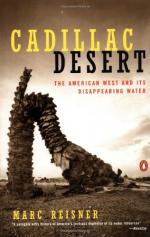
|
| Name: _________________________ | Period: ___________________ |
This test consists of 5 multiple choice questions, 5 short answer questions, and 10 short essay questions.
Multiple Choice Questions
1. The author states in Chapter Ten that agriculture uses what percent of all the water in California?
(a) 45%.
(b) 81%.
(c) 62%.
(d) 22%.
2. The Kern County Land Company later became the main agricultural holding of what conglomerate?
(a) The DiGiorgio Company.
(b) Sierra Pacific Industries.
(c) The Tenneco Corporation.
(d) Irvine Ranch.
3. The author described the Gross National Product of California to be what in Chapter Ten?
(a) $235 billion.
(b) $820 billion.
(c) $485 billion.
(d) $1.13 trillion.
4. In January of 1862, San Francisco recorded how many inches of rain?
(a) 39.
(b) 27.
(c) 18.
(d) 12.
5. According to the author, “[Ronald] Reagan, as a westerner, should have been a friend of dams, but he was growing more conservative by the hour, and true conservatives tend to dislike” what?
(a) “Endless spending.”
(b) “Great public works.”
(c) “Impacting nature.”
(d) “More taxes.”
Short Answer Questions
1. In 1962, there were how many megawatts of installed hydroelectric generating capacity in the United States?
2. What organization does the author refer to “as opportunistic and ruthless an agency as American government has ever seen” in Chapter Six?
3. What handpicked Fresno legislature member once referred to groundwater regulation as “World War III”?
4. Chapter Ten is subtitled what?
5. According to the author in Chapter Ten, “Figures for 1946, published in a Senate report on the acreage limitation, reveal that Standard Oil owned” how many acres in the probable CVP service area?
Short Essay Questions
1. What caused the disappearance of the members of the Hohokam civilization?
2. How is the Gila River in its historic past described by the author?
3. What impressions did Floyd Elgin Dominy make on the members of the Bureau of Reclamation? When was his breakthrough there?
4. Who was Michael Strauss? How is he described by the author?
5. How does the author describe the assets of the members of the Hohokam culture in Chapter Eight?
6. What led to the political downfall of Floyd Elgin Dominy?
7. How does the author describe the conservation movement’s efforts in relation to the water-development interests in Chapter Seven?
8. What were B. B. Moeur’s feelings about the Colorado River Compact?
9. What misconception about California’s climate does the author describe in the beginning of Chapter Ten?
10. How does Marc Reisner describe the winter of 1861-1862 for Californians in Chapter Ten?
|
This section contains 832 words (approx. 3 pages at 300 words per page) |

|




